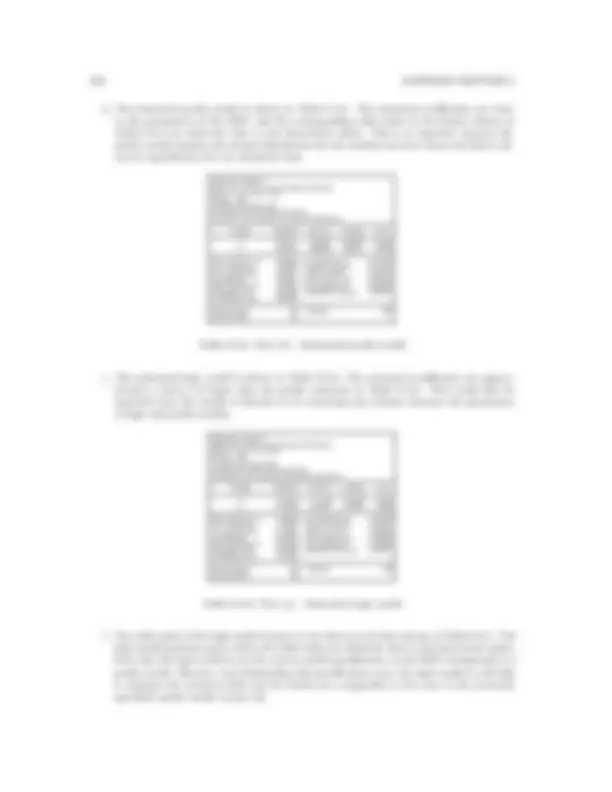



Study with the several resources on Docsity

Earn points by helping other students or get them with a premium plan


Prepare for your exams
Study with the several resources on Docsity

Earn points to download
Earn points by helping other students or get them with a premium plan
Community
Ask the community for help and clear up your study doubts
Discover the best universities in your country according to Docsity users
Free resources
Download our free guides on studying techniques, anxiety management strategies, and thesis advice from Docsity tutors
The theoretical odds ratios and the odds ratios in the sample can be computed as follows. vector(5) tx. ' stores the 5 values of x vector(5) tratio_b. ' ...
Typology: Study notes
1 / 3

This page cannot be seen from the preview
Don't miss anything!


6.7.a. The data can be generated in EViews by means of the following program.
create exer6_7 u 1 200 ’ create workfile genr x = @trend(0) ’ generate series x, ystar and y genr ystar = -10 + 0.1*x + nrnd genr y = (ystar >= 0)
b. The theoretical odds ratios and the odds ratios in the sample can be computed as follows.
vector(5) tx ’ stores the 5 values of x vector(5) tratio_b ’ theoretical odds ratios vector(5) ratio_b ’ odds ratios in sample
tx.fill 60, 80, 100, 120, 140
for !i = 1 to 5 ’ compute odds ratios
tratio_b(!i) = @cnorm(-10+0.1tx(!i))/(1-@cnorm(-10+0.1tx(!i)))
!s1 = (35+!i20) ’ begin of sample !s2 = (45+!i20) ’ end of sample smpl !s1 !s2 ’ adjust sample if @mean(y) <> 1 then ratio_b(!i) = @mean(y)/(1-@mean(y)) else ratio_b(!i) = na endif
next ’ end of for loop
smpl 1 200 scat x ystar ’ scatter diagram
The theoretical and sample odds ratios are shown in Table S 6.2. The sample odds ratio for 95 ≤ xi ≤ 105 (1.2) is quite close to the theoretical value of 1 for x = 100. For 55 ≤ xi ≤ 65 and 75 ≤ xi ≤ 85 all observed values of yi are zero, so the sample odds ratio is also zero. Note that both intervals contain 11 observations, so that these outcomes could be expected on the basis of the theoretical odds ratios (of zero and 0.023 respectively). Further, the sample odds ratios for the intervals 115 ≤ xi ≤ 125 and 135 ≤ xi ≤ 145 can not be determined as all yi have the value 1 in these two subsamples (as could be expected from the large theoretical odds ratios for x = 120 and x = 140). Figure S 6.3 shows the scatter diagram of y∗^ against x. Clearly, around x = 60 and x = 80 there are no values y∗^ > 0, so that y = 0 in these intervals. For instance, for x = 80 there holds y∗^ = −10 + 8 + εi so that P [y∗^ > 0] = P [εi > 2] = 0.023. For similar reasons, around x = 120 and x = 140 there are no values y∗^ < 0 (although in our simulation for xi = 127 the corresponding value y i∗ = 0.479 comes quite close to zero), so that y = 1 in these intervals.
c. The results of OLS are shown in Table S 6.3, and the corresponding estimated odds ratios are given in the third column of Table S 6.4. The OLS estimates of the odds ratios are very imprecise. For small values of x the odds ratio is much overestimated, whereas for large values of x it is much underestimated. That is, the estimated effect of x on the odds ratio is much smaller than the actual effect.
theoretical sample x ratio xi ratio 60 0. 000 55-65 0. 80 0. 023 75-85 0. 100 1. 000 95-105 1. 120 42. 956 115-125 na 140 31573. 386 135-145 na
Table S 6.2: Part (b) : Theoretical and sample odds ratios
0
4
8
12
0 40 80 120 160 200 240
X
YSTAR
Figure S 6.3: Part (b) : Scatter diagram of y∗^ against x
Dependent Variable: Y Method: Least Squares Date: 11/11/02 Time: 15: Sample: 1 200 Included observations: 200 Variable Coefficient Std. Error t-Statistic Prob. C -0.244573 0.036941 -6.620718 0. X 0.007409 0.000319 23.24516 0. R-squared 0.731830 Mean dependent var 0. Adjusted R-squared 0.730476 S.D. dependent var 0. S.E. of regression 0.260230 Akaike info criterion 0. Sum squared resid 13.40850 Schwarz criterion 0. Log likelihood -13.54488 F-statistic 540. Durbin-Watson stat 1.118403 Prob(F-statistic) 0.
Table S 6.3: Part (c) : OLS estimates
x Theoretical OLS Probit Logit 60 0. 000 0. 250 0. 000 0. 001 80 0. 023 0. 534 0. 026 0. 034 100 1. 000 0. 985 0. 919 0. 921 120 42. 956 1. 813 29. 722 24. 513 140 31573. 386 3. 822 10955. 660 657. 636
Table S 6.4: Part (c), (d) and (f) : Estimated odds ratios of OLS, Probit and Logit